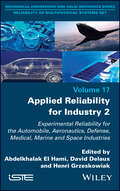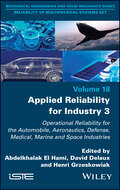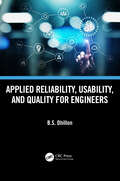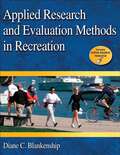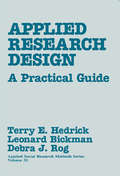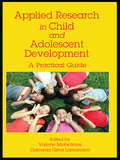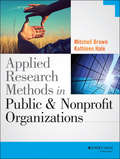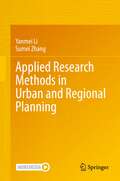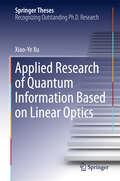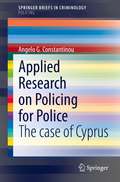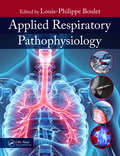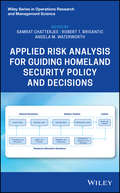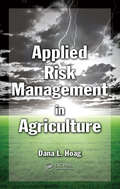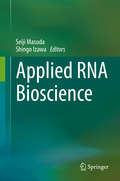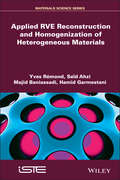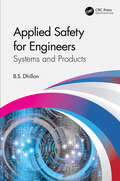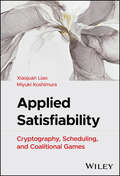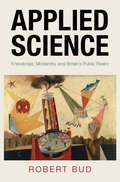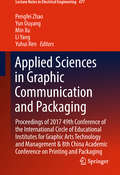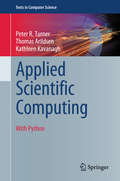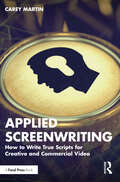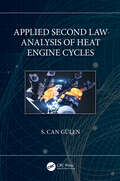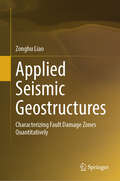- Table View
- List View
Applied Reliability for Industry 2
by Abdelkhalak El Hami David Delaux Henri GrzeskowiakApplied Reliability for Industry 2 illustrates the multidisciplinary state-of-the-art science of experimental reliability. Many experts are now convinced that reliability is not limited to statistical sciences. In fact, many different disciplines interact in order to bring a product to its highest possible level of reliability, made available through today's technologies, developments and production methods. These three books, of which this is the second, propose new methods for analyzing the lifecycle of a system, enabling us to record the development phases according to development time and levels of complexity for its integration. Experimental reliability, as advanced in Applied Reliability for Industry 2, examines all the tools and testing methods used to demonstrate the reliability of the final mechatronic system.
Applied Reliability for Industry 3
by Abdelkhalak El Hami David Delaux Henri GrzeskowiakApplied Reliability for Industry 3 illustrates the multidisciplinary state-of-the-art science of operational reliability. Many experts are now convinced that reliability is not limited to statistical sciences. In fact, many different disciplines interact in order to bring a product to its highest possible level of reliability, made available through today’s technologies, developments and production methods. These three books, of which this is the third, propose new methods for analyzing the lifecycle of a system, enabling us to record the development phases according to development time and levels of complexity for its integration. Operational reliability, as presented in Applied Reliability for Industry 3, verifies the reliability performance of the mechatronic system in real life through an analysis of field data.
Applied Reliability, Usability, and Quality for Engineers
by B.S. DhillonGlobal competition is forcing reliability and other professionals to work closely during the product design and manufacturing phase. Because of this collaboration, reliability, usability, and quality principles are being applied across many diverse sectors of the economy. This book offers the principles, methods, and procedures for these areas in one resource. This book brings together the areas of reliability, usability, and quality for those working in diverse areas to allow them to be exposed to activities that can help them perform their tasks more effectively. This is the only book that covers these areas together in this manner and written in such a way that no previous knowledge is required to understand it. The sources of the material presented are included in the reference section at the end of each chapter along with examples and solutions to test reader comprehension. Applied Reliability, Usability, and Quality for Engineers is useful to design, manufacturing, and systems engineers, as well as manufacturing managers, reliability, usability and, quality specialists. It can also be helpful to graduate, senior undergraduate students, and instructors.
Applied Research and Evaluation Methods in Recreation
by Diane C. BlankenshipThe importance of research and evaluation in the park and recreation industry is becoming increasingly evident as agencies are being asked to justify their existence to a variety of stakeholders. By properly evaluating programs, recreation professionals can better understand the impact of their programs and, with data in hand, justify future investments. Applied Research and Evaluation Methods in Recreation helps students build the competencies they need in order to meet professional standards. <p><p>Applied Research and Evaluation Methods in Recreation is the only text that integrates research, evaluation, and basic statistical analysis and links these concepts directly to the recreation field. Using a logical format and accessible language, the book provides students with the foundational knowledge they need in order to move through the research process. They’ll explore the various types of research commonly used in the field (including qualitative, quantitative, and action research) and then learn about the steps involved in designing a project, from developing the research problem, reviewing literature, and identifying variables and hypotheses to defining the population to study, developing the instrumentation plan, and choosing the appropriate data-collection tools. Then they’ll move on to evaluation concepts, including internal validity, data analysis, and reporting methods. <p><p>The author’s approach to the material makes this textbook truly unique. Each chapter builds on the previous one to clearly explain the steps of the research process and show how all of the concepts are interrelated. Students will learn not only why the steps and concepts are important but also how they relate specifically to the field. Each chapter closes with features that help students apply what they’ve learned: a case study, exercises, and For the Investigator, an ongoing research project that uses a hypothetical recreation survey to give students realistic practice in recreation research. The text contains many other features that will help students better understand and apply the concepts they’ve learned. Chapter-opening scenarios offer examples of the kinds of research that students might be expected to undertake. Objectives highlight the key points of each chapter, and a glossary offers easy access to definitions of unfamiliar terms. Professional Perspectives sidebars describe real research projects from current professionals with an explanation of the project’s importance to the organization. <p><p>Through the practical approach of Applied Research and Evaluation Methods in Recreation, students will gain the foundational knowledge they need in order too become confident in using their research and evaluation skills to meet the demands of their profession.
Applied Research Design: A Practical Guide (Applied Social Research Methods #Vol. 32)
by Leonard Bickman Terry E. Hedrick Ms Debra J. RogTo help researchers and students make the transition from the classroom and laboratory to research in the `real world,' the authors reveal the pitfalls and suggest strategies to overcome problems in the design and planning of applied research. With a focus on how to refine research questions as real world events force deviations from the original research plan, they discuss how to study and monitor program implementation and statistical power analysis. They also explore how to assess the human and material resources that will be needed at different times while conducting an applied research design to facilitate the management of data collection, analysis, and interpretation.
Applied Research in Child and Adolescent Development: A Practical Guide
by Valerie Malhomes Carmela Gina LomonacoDeveloped for an NIH training institute, this volume is organized around the most frequently asked questions by researchers starting their careers in applied research in child and adolescent development. With contributions from the leading scholars in the field, actual research experiences highlight the challenges one faces in conducting such research. The techniques and theoretical frameworks most suitable for guiding the applied research process are reviewed along with related ethical and cultural considerations. Each chapter features the authors’ introduction to their own careers in applied research. Also included are practical tips, case studies, and sidebars featuring frequently asked questions. This practical resource provides tips on how to: Modify the most frequently used methodological techniques while maintaining the integrity of the data Manage the unpredictable nature of real world research Frame community relevant research questions in an academically acceptable way Secure funding to conduct applied research Disseminate the research results so as to have the greatest impact on policy and practice. The book opens with the most frequently asked questions, tips on getting started in an applied research career, and an overview of and theoretical framework for generating applied developmental research ideas. Section 2 focuses on research designs including the most frequently used methodological and measurement techniques and tips on how to modify them to applied settings. Ethical challenges and cultural issues in working with special populations are also addressed. Section 3 focuses on conducting applied research in school, community, and clinical settings with an emphasis on the challenges encountered when conducting actual research as opposed to the more controlled settings taught in a classroom. Guidelines for protecting the populations involved in the study and strategies for recruiting and retaining participants are also addressed. The book concludes with strategies for disseminating research findings so as to have the greatest impact on policy and practice, for publishing research, and for securing funding. Intended as a practical guide, this book is ideal for those just starting their careers in applied research, for students preparing their dissertations, and for the faculty who prepare these students. The book’s accessible approach also appeals to researchers in the behavioral, social, and health sciences, education, and those in government and industry.
Applied Research Methods in Public and Nonprofit Organizations
by Mitchell Brown Kathleen HaleA complete guide to applied research, featuring original dataand detailed case studies Applied Research Methods in Public and NonprofitOrganizations takes an integrative approach to appliedresearch, emphasizing design, data collection, and analysis. Commoncase studies across chapters illustrate the everyday nature ofresearch, and practical exercises reinforce concepts across allsections of the text. The book includes forms and formats for datacollection and analysis, plus writing excerpts that demonstrateresults reporting and presentation. The accompanying instructor'sguide features assignments, discussion questions, and exercisesreferenced in the book, and the authors' own data sets areavailable for use online.Conducting research, analyzing results, and synthesizing thefindings for key stakeholders is fundamental to the study andpractice of public and nonprofit management. Aligned withmanagement curriculum for both sectors, the book focuses on thecommon ground these organizations share when it comes to planning,conducting, and using research in day-to-day professionalactivities. The original research examples presented are in thecontext of this shared commonality, including resource acquisition,evaluative processes, and future planning through the lens ofcommon social policy issues facing leaders today. Topicsinclude:The research process and applied research designsApplied research questions and literatureData collection in the field and survey researchData analysis, writing, and presentationThe examples highlight intergovernmental institutions in whichpublic service occurs, and provide expanded reach to nonprofitorganizations and the networked collaborations that make up asignificant portion of today's public service. For students andpractitioners of public administration, public policy, andnonprofit management, Applied Research Methods in Public andNonprofit Organizations provides a comprehensive reference tothis critical skillset.
Applied Research Methods in Urban and Regional Planning
by Yanmei Li Sumei ZhangThis book introduces the fundamentals of research methods and how they apply to the discipline of urban and regional planning. Written at a level appropriate for upper-level undergraduate and beginning master’s level students, the text fills a gap in the literature for textbooks on urban planning. Additionally, the book can be used as a reference for planning practitioners and researchers when analyzing quantitative and qualitative data in urban and regional planning and related fields.The volume does not assume advanced knowledge of mathematical formulas. Rather, it begins with the essentials of research methods, such as the identification of the research problems in planning, the literature review, data collection and presentation, descriptive data analysis, and report of findings. Its discipline-specific topics include field research methods, qualitative data analysis, economic and demographic analysis, evaluation research, and methods in sub-disciplines such as land use planning, transportation planning, environmental planning, and housing analysis. Designed with instruction in mind, this book features downloadable materials, including learning outcomes, chapter highlights, chapter review questions, datasets, and certain Excel models. Students will be able to download review questions to enhance the learning process and datasets to practice methods.
Applied Research of Quantum Information Based on Linear Optics (Springer Theses)
by Xiao-Ye XuThis thesis reports on outstanding work in two main subfields of quantum information science: one involves the quantum measurement problem, and the other concerns quantum simulation. The thesis proposes using a polarization-based displaced Sagnac-type interferometer to achieve partial collapse measurement and its reversal, and presents the first experimental verification of the nonlocality of the partial collapse measurement and its reversal. All of the experiments are carried out in the linear optical system, one of the earliest experimental systems to employ quantum communication and quantum information processing. The thesis argues that quantum measurement can yield quantum entanglement recovery, which is demonstrated by using the frequency freedom to simulate the environment. Based on the weak measurement theory, the author proposes that white light can be used to precisely estimate phase, and effectively demonstrates that the imaginary part of the weak value can be introduced by means of weak measurement evolution. Lastly, a nine-order polarization-based displaced Sagnac-type interferometer employing bulk optics is constructed to perform quantum simulation of the Landau-Zener evolution, and by tuning the system Hamiltonian, the first experiment to research the Kibble-Zurek mechanism in non-equilibrium kinetics processes is carried out in the linear optical system.
Applied Research on Policing for Police: The case of Cyprus (SpringerBriefs in Criminology)
by Angelo G. ConstantinouThis brief discusses a series of empirical studies on policing in Cyprus, applying research to practice. It discusses police culture and tactics, and addresses politicized policing. Using primary data based on both quantitative and qualitative studies on the day-to-day issues of front-line policing in Cyprus, this volume will be of interest to academics, researchers and practitioners interested in comparative international policing, evidence-based policing, and contextualization of policing in Cyprus.
Applied Research Technologies, Inc.: Global Innovation's Challenges
by Christopher A. Bartlett Heather BeckhamApplied Research Technologies, Inc. (ART) is a diversified technology company which has used its entrepreneurial culture and encouragement of innovation as an ongoing competitive advantage. The case concentrates on the challenges faced by Peter Vyas, the Filtration Unit manager, who must decide whether to request $2 million in project funding from the divisional vice president, Cynthia Jackson. Similar Filtration projects have failed twice before, damaging the credibility of the Filtration Unit and Vyas personally. Jackson has recently been challenged to turn around or shut down the unit. Students must determine a strategy from the perspectives of both a unit manager and a division VP. This two-tier focus provides the opportunity to analyze the management decision process at different levels of the organization. Topics include empowerment, project management, and managing innovation.
Applied Research Technologies, Inc.: Global Innovation's Challenges
by Christopher A. Bartlett Heather BeckhamApplied Research Technologies, Inc. (ART) is a diversified technology company which has used its entrepreneurial culture and encouragement of innovation as an ongoing competitive advantage. The case concentrates on the challenges faced by Peter Vyas, the Filtration Unit manager, who must decide whether to request $2 million in project funding from the divisional vice president, Cynthia Jackson. Similar Filtration projects have failed twice before, damaging the credibility of the Filtration Unit and Vyas personally. Jackson has recently been challenged to turn around or shut down the unit. Students must determine a strategy from the perspectives of both a unit manager and a division VP. This two-tier focus provides the opportunity to analyze the management decision process at different levels of the organization. Topics include empowerment, project management, and managing innovation.
Applied Respiratory Pathophysiology
by Louis-Philippe BouletThis easy yet comprehensive reference guide covers the mechanisms of respiratory diseases, explaining the main respiratory conditions for clinicians and postgraduate trainees. It discusses their aetiology as well as the basic concepts required to effectively evaluate and treat them. Applied Respiratory Pathophysiology is the first book to bring together detailed, clinically-relevant explanation of respiratory physiological processes and pathophysiological processes in one text. It is essential reading for anyone diagnosing and treating specific clinical conditions of the lungs.
Applied Risk Analysis for Guiding Homeland Security Policy and Decisions (Wiley Series in Operations Research and Management Science)
by Samrat Chatterjee Robert T. Brigantic Angela M. WaterworthPresents various challenges faced by security policy makers and risk analysts, and mathematical approaches that inform homeland security policy development and decision support Compiled by a group of highly qualified editors, this book provides a clear connection between risk science and homeland security policy making and includes top-notch contributions that uniquely highlight the role of risk analysis for informing homeland security policy decisions. Featuring discussions on various challenges faced in homeland security risk analysis, the book seamlessly divides the subject of risk analysis for homeland security into manageable chapters, which are organized by the concept of risk-informed decisions, methodology for applying risk analysis, and relevant examples and case studies. Applied Risk Analysis for Guiding Homeland Security Policy and Decisions offers an enlightening overview of risk analysis methods for homeland security. For instance, it presents readers with an exploration of radiological and nuclear risk assessment, along with analysis of uncertainties in radiological and nuclear pathways. It covers the advances in risk analysis for border security, as well as for cyber security. Other topics covered include: strengthening points of entry; systems modeling for rapid containment and casualty mitigation; and disaster preparedness and critical infrastructure resilience. Highlights how risk analysis helps in the decision-making process for homeland security policy Presents specific examples that detail how various risk analysis methods provide decision support for homeland security policy makers and risk analysts Describes numerous case studies from academic, government, and industrial perspectives that apply risk analysis methods for addressing challenges within the U.S. Department of Homeland Security (DHS) Offers detailed information regarding each of the five DHS missions: prevent terrorism and enhance security; secure and manage our borders; enforce and administer our immigration laws; safeguard and secure cyberspace; and strengthen national preparedness and resilience Discusses the various approaches and challenges faced in homeland risk analysis and identifies improvements and methodological advances that influenced DHS to adopt an increasingly risk-informed basis for decision-making Written by top educators and professionals who clearly illustrate the link between risk science and homeland security policy making Applied Risk Analysis for Guiding Homeland Security Policy and Decisions is an excellent textbook and/or supplement for upper-undergraduate and graduate-level courses related to homeland security risk analysis. It will also be an extremely beneficial resource and reference for homeland security policy analysts, risk analysts, and policymakers from private and public sectors, as well as researchers, academics, and practitioners who utilize security risk analysis methods.
Applied Risk Management in Agriculture
by Dana L. HoagDefining the fundamentals of building a risk management plan, Applied Risk Management in Agriculture uses strategic management to organize the process of risk management. A time-tested procedure inside and outside the business community, this technique provides an ideal platform for organizing risk.Making complex principles easily accessible to stu
Applied RNA Bioscience
by Seiji Masuda Shingo IzawaThe focus of this book is to introduce up-to-date information on applications and practical use of RNA for agriculture, biotechnology and medicine.<P><P> It provides unique ideas, tools, and methods in detail from a variety of scientific and technical disciplines. RNA science has progressed enormously in recent decades, and vast amounts of information on RNA functions and their regulatory mechanisms are becoming available. Such a progress opened the door to an age of practical application of RNA in many fields including agriculture, plant science, medical science, brewing and fermentation technology, and material production. <P>This book inspires its readership and contributes to not only expansion in application of RNA but also to basic research.
Applied RVE Reconstruction and Homogenization of Heterogeneous Materials
by Majid Baniassadi Hamid Garmestani Yves Rémond Said AhziStatistical correlation functions are a well-known class of statistical descriptors that can be used to describe the morphology and the microstructure-properties relationship. A comprehensive study has been performed for the use of these correlation functions for the reconstruction and homogenization in nano-composite materials. Correlation functions are measured from different techniques such as microscopy (SEM or TEM), small angle X-ray scattering (SAXS) and can be generated through Monte Carlo simulations. In this book, different experimental techniques such as SAXS and image processing are presented, which are used to measure two-point correlation function correlation for multi-phase polymer composites. Higher order correlation functions must be calculated or measured to increase the precision of the statistical continuum approach. To achieve this aim, a new approximation methodology is utilized to obtain N-point correlation functions for multiphase heterogeneous materials. The two-point functions measured by different techniques have been exploited to reconstruct the microstructure of heterogeneous media. Statistical continuum theory is used to predict the effective thermal conductivity and elastic modulus of polymer composites. N-point probability functions as statistical descriptors of inclusions have been exploited to solve strong contrast homogenization for effective thermal conductivity and elastic modulus properties of heterogeneous materials. Finally, reconstructed microstructure is used to calculate effective properties and damage modeling of heterogeneous materials.
Applied Safety for Engineers: Systems and Products
by B.S. DhillonGlobal competition and other factors are forcing manufacturers to produce highly safe engineering systems and products. This book meets the needs for product designers, systems engineers, and safety engineers that work together and need a single resource which considers all three areas when designing new products and systems that they can refer to. Applied Safety for Engineers: Systems and Products serves as a comprehensive resource offering a wide range of safety topics when involved with product design, engineering system analysis, and engineering maintenance. Examples along with their solutions are placed at the end of each chapter to test reader comprehension. The book facilitates the importance for product designers, safety, and systems engineering professionals to work closely during the product design phase so they can understand each other’s discipline. Written in a manner that readers do not need any previous knowledge on the subject, the book offers many sources for further reading at the end of each chapter. This book will be useful to product designers, system engineers, safety specialists, graduate and senior undergraduate students, researchers and manufacturers, industrial engineers, safety engineers, and engineers-at-large.
Applied Satisfiability: Cryptography, Scheduling, and Coalitional Games
by Xiaojuan Liao Miyuki KoshimuraApply satisfiability to a range of difficult problems The Boolean Satisfiability Problem (SAT) is one of the most famous and widely-studied problems in Boolean logic. Optimization versions of this problem include the Maximum Satisfiability Problem (MaxSAT) and its extensions, such as partial MaxSAT and weighted MaxSAT, which assess whether, and to what extent, a solution satisfies a given set of problems. Numerous applications of SAT and MaxSAT have emerged in fields related to logic and computing technology. Applied Satisfiability: Cryptography, Scheduling, and Coalitional Games outlines some of these applications in three specific fields. It offers a huge range of SAT applications and their possible impacts, allowing readers to tackle previously challenging optimization problems with a new selection of tools. Professionals and researchers in this field will find the scope of their computational solutions to otherwise intractable problems vastly increased. Applied Satisfiability readers will also find: Coding and problem-solving skills applicable to a variety of fieldsSpecific experiments and case studies that demonstrate the effectiveness of satisfiability-aided methodsChapters covering topics including cryptographic key recovery, various forms of scheduling, coalition structure generation, and many more Applied Satisfiability is ideal for researchers, graduate students, and practitioners in these fields looking to bring a new skillset to bear in their studies and careers.
Applied Science: Knowledge, Modernity, and Britain's Public Realm (Science in History)
by Robert BudFor almost two centuries, the category of 'applied science' was widely taken to be both real and important. Then, its use faded. How could an entire category of science appear and disappear? By taking a longue durée approach to British attitudes across the nineteenth and twentieth centuries, Robert Bud explores the scientific and cultural trends that led to such a dramatic rise and fall. He traces the prospects and consequences that gave the term meaning, from its origins to its heyday as an elixir to cure many of the economic, cultural, and political ills of the UK, eventually overtaken by its competitor, 'technology'. Bud examines how 'applied science' was shaped by educational and research institutions, sociotechnical imaginaries, and political ideologies and explores the extent to which non-scientific lay opinion, mediated by politicians and newspapers, could become a driver in the classification of science.
Applied Sciences in Graphic Communication and Packaging: Proceedings of 2017 49th Conference of the International Circle of Educational Institutes for Graphic Arts Technology and Management & 8th China Academic Conference on Printing and Packaging (Lecture Notes in Electrical Engineering #477)
by Min Xu Li Yang Yun Ouyang Pengfei Zhao Yuhui RenThis book includes a selection of reviewed papers presented at the 49th Conference of the International Circle of Educational Institutes for Graphic Arts Technology and Management & 8th China Academic Conference on Printing and Packaging, which was held on May 14-16, 2017 in Beijing, China. The conference was jointly organized by the Beijing Institute of Graphic Communication, China Academy of Printing Technology, and International Circle of Educational Institutes for Graphic Arts Technology and Management. With eight keynote talks and 200 presented papers on graphic communication and packaging technologies, the event attracted more than 400 scientists. The proceedings cover the latest advances in color science and technology; image processing technology; digital media technology; digital process management technology in packaging; packaging, etc. , and will be of interest to university researchers, R&D engineers and graduate students in the graphic arts, packaging, color science, image science, material science, computer science, digital media and network technology.
Applied Scientific Computing: With Python (Texts in Computer Science)
by Peter R. Turner Thomas Arildsen Kathleen KavanaghThis easy-to-understand textbook presents a modern approach to learning numerical methods (or scientific computing), with a unique focus on the modeling and applications of the mathematical content. Emphasis is placed on the need for, and methods of, scientific computing for a range of different types of problems, supplying the evidence and justification to motivate the reader. Practical guidance on coding the methods is also provided, through simple-to-follow examples using Python.Topics and features: provides an accessible and applications-oriented approach, supported by working Python code for many of the methods; encourages both problem- and project-based learning through extensive examples, exercises, and projects drawn from practical applications; introduces the main concepts in modeling, python programming, number representation, and errors; explains the essential details of numerical calculus, linear, and nonlinear equations, including the multivariable Newton method; discusses interpolation and the numerical solution of differential equations, covering polynomial interpolation, splines, and the Euler, Runge–Kutta, and shooting methods; presents largely self-contained chapters, arranged in a logical order suitable for an introductory course on scientific computing.Undergraduate students embarking on a first course on numerical methods or scientific computing will find this textbook to be an invaluable guide to the field, and to the application of these methods across such varied disciplines as computer science, engineering, mathematics, economics, the physical sciences, and social science.
Applied Screenwriting: How to Write True Scripts for Creative and Commercial Video
by Carey MartinPutting a vision on the page for creative and commercial video is harder than it seems, but author Carey Martin explains how to bring these tools to bear in the “work for hire” environment. Whilst other texts focus on writing the next award winner, this can be out of reach both logistically and financially for many. Instead, readers will learn how to write what they want the eyes of the audience to see and the ears of the audience to hear, in such a way that the Producer and Director can read the creative blueprint and bring that vision to life. The text will walk readers through a focused and practical consideration of the camera, the edit, and the sound design, in addition to a straightforward application of basic story principles. By understanding writing for video as more than creating a recorded play, readers will become more effective screenwriters and, should they wish, Producers and Directors as well. This book is ideal for students of screenwriting and those writing scripts for message-driven video for corporate, nonprofit, and commercial production.
Applied Second Law Analysis of Heat Engine Cycles
by S. Can GülenApplied Second Law Analysis of Heat Engine Cycles offers a concise, practical approach to one of the two building blocks of classical thermodynamics and demonstrates how it can be a powerful tool in the analysis of heat engine cycles. Including real system models with the industry-standard heat balance simulation software, the Thermoflow Suite (GTPRO/MASTER, PEACE, THERMOFLEX) and Excel VBA, the book discusses both the performance and the cost. It also features both calculated and actual examples for gas turbines, steam turbines, and simple and combined cycles from major original equipment manufacturers (OEMs). In addition, novel cycles proposed by researchers and independent technology developers will also be critically examined. This book will be a valuable reference for practicing engineers, enabling the reader to approach the most difficult thermal design and analysis problems in a logical manner.
Applied Seismic Geostructures: Characterizing Fault Damage Zones Quantitatively
by Zonghu LiaoThis book focuses on the characterization of fault damage zones and subsurface structure systems quantitatively for the first time. It provides a comprehensive case study of various types of fault damage zones, including normal, reverse, strike-slip, and composite zones. The book also explores fractures within fault damage zones and the effect of faulting on cap rock integrity. Through meticulous case studies and analyses from diverse geographical regions, this book elucidates the seismic characteristics and behaviors associated with fault damage zones. Readers will find particular interest in the methods and results presented in the book, as it offers a holistic and systematic approach to understanding and building seismic geostructures. Incorporating seismic attributes and coherence analysis, as well as applying neural networks, it provides readers with innovative techniques in fault characterization and segmentation. Besides, this book incorporates illustrative visuals, insightful tables, and cutting-edge seismic attributes, which enhance the reader's understanding of the subject matter. Researchers, professionals, and students in petroleum geology, geophysics, and engineering will find this book to be an invaluable resource with the practical insights and innovative methodologies it offers for the state-of-the-art characterizing and analyzing fault damage zones.
